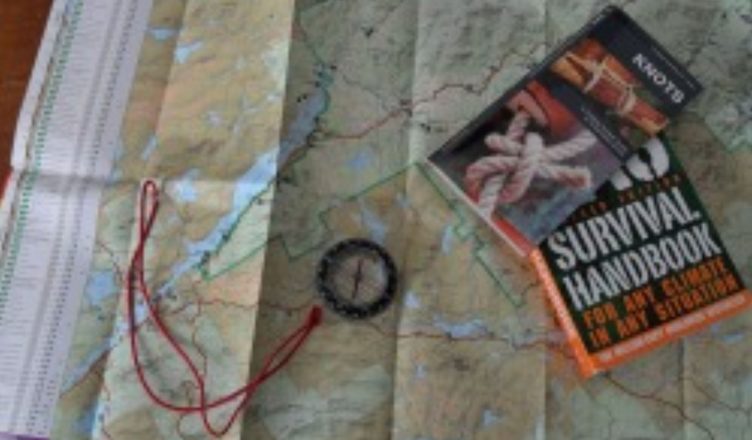Even if you’re not an avid camper or backcountry enthusiast, knowing how to survive in the wild is at the core of a survivalist’s mindset. After all, 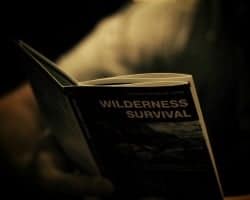 our survival instinct originated from our most primitive form’s need to navigate and overcome the harsh elements that Mother Nature can throw at us. As a result, the training and skills for any survival situation, no matter how specific, can consequently trace their roots back to the basic foundation of surviving in the wilderness, as many of the core lessons and concepts are universal. Gaining proficiency in these basic concepts is a must if you want to be prepared for anything.
our survival instinct originated from our most primitive form’s need to navigate and overcome the harsh elements that Mother Nature can throw at us. As a result, the training and skills for any survival situation, no matter how specific, can consequently trace their roots back to the basic foundation of surviving in the wilderness, as many of the core lessons and concepts are universal. Gaining proficiency in these basic concepts is a must if you want to be prepared for anything.
By Joshua Valentine, a contributing author to Survival Cache and SHTFBlog
The Separation is in the Preparation!
Often people’s first instinct towards surviving in the wild is to build a survival kit that will allow them to do so. While it is certainly an important tool, it should be secondary in one’s mind. Take the time to educate yourself in basic wilderness skills, such as map reading, navigation, weather patterns, first aid, and so on. All the equipment in the world is useless in the hands of someone who does not know how to use and apply them to the situation they are in. Which brings us to our first point:
1) Knowledge Is Power: Know Where You’re Going
Just because you don’t intentionally set out into the wilderness doesn’t mean you can’t wind up lost out in it all the same. A plane crash, a 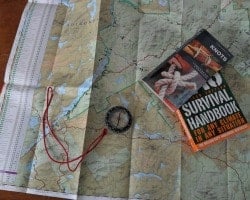 boating accident, a sudden storm snowing your car into a remote pass, or any other number of things can find you unwittingly forced to navigate the rigors of the wild.
boating accident, a sudden storm snowing your car into a remote pass, or any other number of things can find you unwittingly forced to navigate the rigors of the wild.
Learn about your surroundings. What directions are the prevailing winds? What are major landmarks, such as mountain ranges or bodies of water, and what is their proximity and orientation to cities, roads, or other aspects of civilization? What hemisphere are you in, and consequently what celestial bodies or constellations can help you to navigate?
Is it a cold climate? Hot? Does it have an abundance of water, or is it extremely difficult to come by? Is it a hostile or militarized area? What is the local animal and plant life? Are there major predators? Is it prone to major catastrophes, such as avalanche or flooding? Is it conducive to rescue, or will you likely have to rely on self-rescue?
The more you know about your surroundings, the easier it will be for you to adapt, navigate, and overcome obstacles to ultimately survive. It will also serve as your guide for building a situational-appropriate survival kit, which we’ll touch on more a bit later.
2) Knowledge Can Be Life Saving: Let Someone Else Know Where You’re Going
Whether it’s a day hike on the Appalachian Trail or a three-week trek in Peru, you increase your chances of survival exponentially by letting someone else know where you will be. If your plane goes down, they will begin to search for you by tracking the plane to the crash.
It is no different in any other situation: Search and Rescue will begin to look in the area you were last seen or known to be in. Let someone know not only where you will be, but also a rough itinerary and a time frame that, if exceeded, is grounds for alarm.
Know when to S.T.O.P.
At the height of the realization that you are lost in the wild, the hardest thing to do is to sit still. Hearts are racing, adrenaline is pumping, and with the urge to self preserve in the forefront of one’s mind, the last thing anyone wants to do in most cases is to sit still. Yet often times, it can be the best possible thing you can do.
S.T.O.P. stands for Sit, Think, Observe, and Plan.
Sit: Slow down, catch your breath, and take a moment to clear your head and address the situation with a poised outlook. Decisions made frantically and out of fear will always yield negative results. A calm, clear mind will allow you to make the rational decisions you will need to stay alive, and to conserve much needed energy for important tasks, rather than wasting it on panic.
Think: Where are you? How long have you been lost? Are you well supplied, or at a lack? Do you have water and shelter? How much time is left in the day? Are you able to get yourself out, or is it better to prepare to spend the night to avoid getting more lost? These are just some of the questions you should answer as you begin to assess your situation.
Also Read: 8 Common Mistakes of Wilderness Survival
Observe: What is around me that might help me solve these problems? Do I have resources for shelter, water, or fire? Am I in a safe place, or in a danger zone? Once you have assessed your situation, take in your surroundings for possible ways to solve or minimize problems and optimize strengths and advantages.
Plan: Once you have gathered all your information, formulate a plan. Don’t be overwhelmed by the grandeur of your situation. Focus instead on small, step by step tasks towards the ultimate goal of staying alive.
Know the Rule of Three’s
The Rule of Three’s is a helpful guide to prioritizing your plan in a survival situation, by spelling out the average time a person can 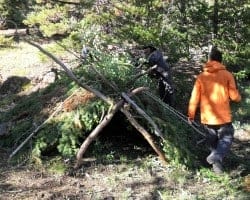 survive without basic needs. According to the rule of three’s you can survive:
survive without basic needs. According to the rule of three’s you can survive:
3 weeks without food
3 days without water
3 hours without shelter
3 minutes without air
When teaching survival courses, I add one final category: 3 seconds without a POSITIVE ATTITUDE
It is generally met with a chuckle or two when I explain it, but DO NOT underestimate the importance of this category. It is the one, above all others, that gives you the best chance of staying alive. Just as one can have all the kit in the world, and still be doomed by not knowing what to do with it, one can have every odd in their favor, yet without the will to push on and live; they are as good as finished.
Knowing the Rule of Three’s will help you to structure and schedule to your Plan phase of S.T.O.P. For example, I often ask students to list their priorities in a survival situation. More often than not food will be near or at the top of the list, with things like shelter near the bottom.
Also Read: AR-7 Survival Rifle Review
If one were to follow that mindset in a survival situation, they could unwittingly burn countless energy and time searching for food, something that they could live without for weeks, and never take the time to build a life saving shelter that would get them safely through the night. By knowing your Rule of Three’s, you can assess your situation, and develop a concise plan of action in accordance with your immediate needs for survival.
It is important to remember that, like anything, the Rule of Three’s is situational. For example, in a temperate forest in summer, one could potentially last far longer than three hours without shelter. Yet in a winter clime, one could have significantly less than three hours to establish shelter, just as three days without water could suddenly shorten, were one lost in a hot, arid setting such as a desert.
Fire is a Friend!
Unless you find yourself in hostile territory, where you do not wish to be discovered, then fire is a huge asset. I often list fire alongside 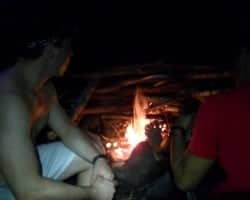 shelter when I teach the Rule of Three’s. Fire can keep you warm, dry, purify water, cook food, protect you from predators, and even keep you company. It may sound crazy, but there is a proven, psychological benefit to having a fire. A positive attitude is everything, as you will hear me stress repeatedly throughout this piece, so anything that provides a boost is a good thing!
shelter when I teach the Rule of Three’s. Fire can keep you warm, dry, purify water, cook food, protect you from predators, and even keep you company. It may sound crazy, but there is a proven, psychological benefit to having a fire. A positive attitude is everything, as you will hear me stress repeatedly throughout this piece, so anything that provides a boost is a good thing!
Also Read: The Best Fire Starters For Survival
Focus on the Small Steps, and Conserve Energy
Allowing yourself to be wrapped up in the grandeur of being lost in the wild can be intimidating, or outright dangerous. Many people perish simply by becoming consumed by what went wrong to land them in their situation, rather than taking the simple steps that could have kept them alive. Focus on your plan, and taking one step at a time towards achieving it. Not only will you be taking life saving measures, but it will also keep you focused and busy, and help you to stay positive. On top of that, it will prevent you from wasting precious energy on tasks that are not priority. Life is a simple science of calories in the wild, so make sure every one counts!
Know when to Stay Put, Know When to Move
In most cases, staying put will likely give you the greatest chance for survival, especially if you took all the appropriate steps before 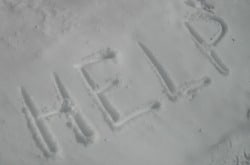 setting out. As long as you are not in an immediate danger zone, such as an avalanche chute or a flash flood gully, staying put gives your rescuers the best chance of finding you, as they are going to start looking in the last place you were seen, or known to be.
setting out. As long as you are not in an immediate danger zone, such as an avalanche chute or a flash flood gully, staying put gives your rescuers the best chance of finding you, as they are going to start looking in the last place you were seen, or known to be.
That said, you cannot always count on others to be rescued. In some situations, should your present environment be too volatile, or devoid of resources, you will be forced to move. Are those fresh grizzly tracks all around your camp? Perhaps there is an injured member of your party, who only has precious time to reach the sanctity of rescue. Perhaps you are in a hostile region, or you know that you are in close enough proximity to civilization to get yourself out.
Being mentally prepared and able to self-rescue is an invaluable tool. If you must move, and are not in hostile territory, take the time to leave information behind for potential rescuers. If you can, let them know where you are headed, how long ago you left, and how dire your situation is. This can be as complex as a written note, or as simple as a symbol carved into the ground or a tree.
If you are going to stay put, take all steps necessary to make yourself visible to your rescuers! Build signal fires, stuffed with live greens to make them smoky. If you have a clearing, spell HELP as large as possible, so that it can be seen from the air. Anything you can do to help them will ultimately help you!
Build an Appropriate Survival Kit
I list this category near the bottom to reinforce the point I first made: That in the end, knowledge is a power far greater than the contents 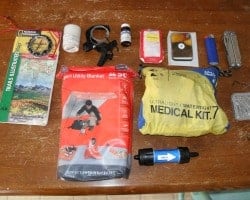 of any kit. The more knowledge one has, the more confidence they will have to handle a situation, and thus cultivate and maintain that life-saving positive outlook on a situation. That being said, you can get a lot further a lot faster with the right kit!
of any kit. The more knowledge one has, the more confidence they will have to handle a situation, and thus cultivate and maintain that life-saving positive outlook on a situation. That being said, you can get a lot further a lot faster with the right kit!
A survival situation is not static; it is dynamic, and ever changing. A survival kit should be no different. It is the ability to adapt and overcome that will keep you alive, therefore be prepared to adapt your kit accordingly. Just as researching and understanding the area you will be in will allow you key survival knowledge, it will also provide a guideline on how to ideally construct your survival kit to be specific to that area. Once you have built it, make sure you know it inside out! A bunch of equipment that you haven’t tested or don’t know how to use may as well be back at home!
Above All Else, Maintain a Positive Attitude
I can’t stress this point enough. Remember to focus always on the positive, such as what has gone right rather than what is going wrong. Some keep a picture of family or a loved one in their survival kit. It may sound silly, but remembering who and what you have to live for can go a long way in your darkest moments. Everything listed above is going to greatly increase your chances of survival, but in the end, it will be your determination and will to live that will make the ultimate difference.
About Joshua Valentine: A lifelong outdoors and survival expert, Josh combines years of backcountry experience with a lifetime of unique and inventive fitness training, designed to prepare the body and mind for the rigors of the wilderness. Josh holds certifications as a Wilderness First Responder (WFR), American Canoe Association Whitewater Raft Guide (ACA), and Personal Trainer (AFAA). He is also a recorded Adirondack 46’r and White Mountain 4,000 Footer.


